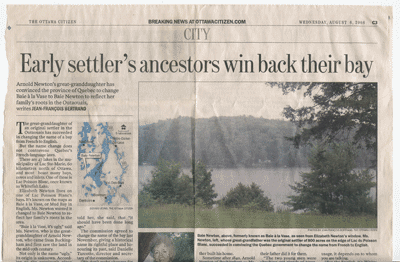
Last August our lake was featured in the Ottawa Citizen, in the City section detailing a long battle to get the name of one of the main bays changed.
While some of you may already know this, others probably aren’t aware of an official name change on one of the most popular bays on the lake. Formerly known as “Baie a la Vase”, or “Mud Bay”, the bay is now known as “Newton Bay” in respect to Betty Newton and her family who were the first settlers on the lake.
Elizabeth Newton, who is somewhat of a celebrity around the bay because of how long her family has been maintaining the land, helping lost campers and directing people to cottages they can’t find, is the great granddaughter of the original settler on the lake, that came from Buckingham. His name was Arnold Newton and he first settled in the area sometime in the mid-19th century.
Why the bay was originally called “Mud Bay” is a little bit a mystery. Nobody can figure out where this came from except that the first recorded name was in 1981 on a field survey that was conducted in and around the lake.
Elizabeth thought this name made no sense, and over 200 people who signed her petition agreed with her. The petition was submitted to the municipality and they agreed to change the name of the bay officially.
Officially the bay is called “La Baie Newton” to comply with Quebec’s language laws, even though the name is somewhat of an English name, with the important “la baie” it fits under 1977 Quebec Language Charter.
How did all of this come about? Early in the 19th century, Elizabeth’s great-grandfather sent his two sons, who weren’t even 21 years old yet, on a wild adventure up the Riviere La Lievre to stake out some potential property that was coming up in a land grant. In those days, in order for the colonization office to grant any acreage the settlers first had five years to clear the land and then establish themselves. After this time they could apply for a patent, which would give them the full title to the land. If those conditions weren’t met, then the land would revert back to the colonization office. Whitefish Lake was one such property.
According to Newton family stories, the two sons who originally staked out the land were too young to file it a claim for themselves. Their father decided to help them out by getting the deed in his name. Back then, there wasn’t as much infrastructure around the area, just a number of small hamlets. One such hamlet was Ryanville, which the two boys stumbled upon. Ryanville is now the area surrounding the ski hill Mont Ste Marie, and no longer exists except for in story. This is where Bill Newton established himself, while his brother – Elizabeth’s grandfather – established himself on around 800 acres of land close to Newton Bay. This eventually became known as Whitefish, and has stuck ever since.
One of the questions overheard quite frequently up at the lake is “Is it Whitefish Lake, or Lac du Poisson Blanc?” The straight answer is that under the government, since 1931 it’s been known as “Lac du Poisson Blanc”. However when speaking, it’s commonly referred to as both – English people tend to call it Whitefish Lake, while French speaking people call it Lac du Poisson Blanc.
The Newton family is not only known for renaming the bay, in the early 1950’s Elizabeth Gertrude donated an acre of land to be used for a church, Notre-Dame-Du-Lac du Grand Poisson Blanc, which held summer services for campers and cottagers until 1973. Not to mention, nearly a century after her ancestors created the hamlet and settled there, Elizabeth Muriel Newton was instrumental in bringing electricity to this part of the lake, which had previously relied only on propane for heat and lighting.

